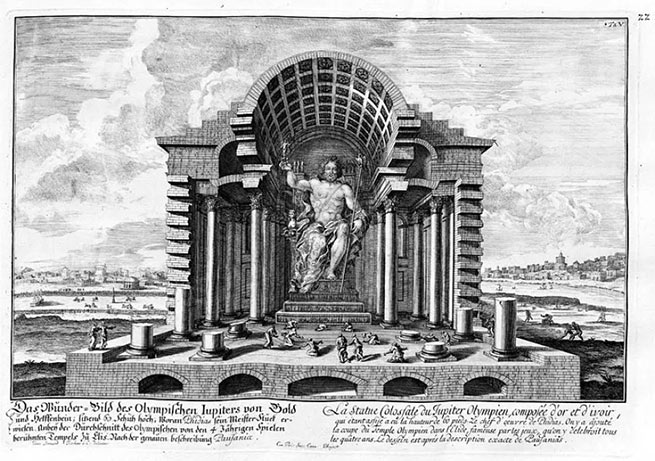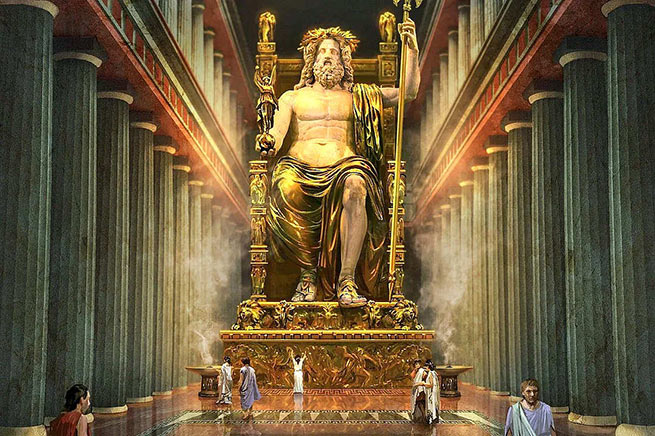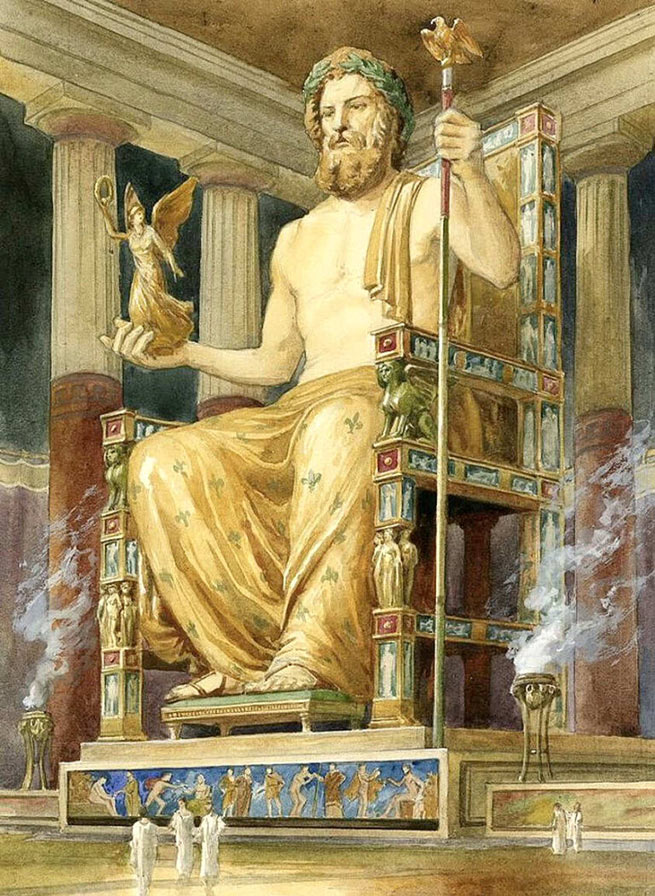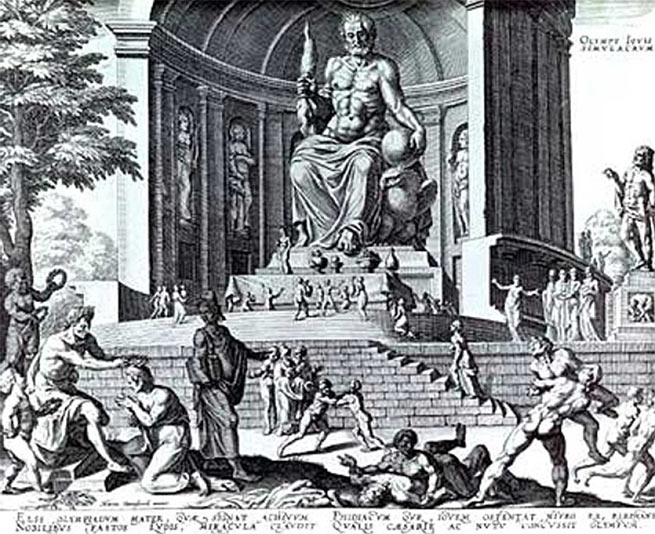One of the seven wonders of the ancient world “comes to life” after 2500 years! This is the famous statue of Zeus in gold and ivory, created by the great sculptor Phidias around 430 BC. and installed in the temple of Zeus, in the sanctuary of Olympia.
The colossal 13-meter statue, which was completely destroyed in 426 AD, was restored for the first time in the world by the Museum of Ancient Greek Technologies Kotsan and will be on display until September 30 as part of the “Two Gods” exhibition organized in the center of Ancient Olympia, with free admission to the public, it is part of the larger “7 Wonders of Antiquity” exhibition.
Statue of Olympian Zeus depicted in 1572
Particularly impressive is the accuracy of the image, which took three whole years of systematic research and construction, based on relevant bibliographic and archaeological sources. Among them are the ancient coins of Elis, which accurately reproduce his figure and the descriptions of Pausanias in Helias.
The statue of Olympian Zeus was one of the most magnificent and impressive monuments of antiquity, to which crowds of people flocked to admire and pray.
This was the goal of the inhabitants of Elis when they asked Phidias to build it, that is, to make it a pole of attraction and a sign of power. Knowing about the famous and huge statue of Athena in gold and ivory, which he created for the Parthenon, they asked him to create something similar and perhaps even more impressive, which would reflect the glory and power, equivalent to the glory and power of the father of the gods.
And the great sculptor again performed a miracle, which took eight long years of work. The seated skeleton of Zeus was made of wood and soaked in a special liquid to prevent it from drying out and warping. The tree was covered with layers of gold and ivory plates, the eyes were made of precious stones, and the mantle was made of marble covered with gold leaf.

Engraving from 1721
On the head of Zeus, seated on an impressive throne made of ivory, gold, ebony and precious stones, was a wreath of green enamel. In his right hand, Zeus held a statue of the goddess Nike made of gold and ivory with a ribbon and a crown on his head, and in his left hand, his scepter, made of various types of metal and crowned with an eagle, the god’s trademark. Two imitations of resting lions were at his feet, giving a sense of vigilant protection. Small animals and lily flowers are carved on the figure’s robe. The base, foot and throne of Zeus were decorated with 173 figures.
Phidias was especially proud of this work. It is even said that when he completed it, he prayed to Zeus, asking him to send him a sign to show his approval. And at that moment there was a thunderclap, which he perceived as the divine answer he had been waiting for.

1887 illustration
Various versions of the destruction of the statue
The impressive statue is believed to have been completely destroyed and subsequently looted in 426 AD after the entire temple was set on fire. According to another version, it was brought to Constantinople by Theodosius and placed in the palace of a Greek Christian eunuch, where it remained for about 60 years, along with other great works of art, until 475 AD, when it was destroyed by a great fire.
Finally, according to the Roman historian Suetonius, the emperor Caligula had the statue brought to Rome and the face of the two statues replaced with his own. However, his wish was never granted as the ship carrying him was struck by lightning.
But there is also a version that says that when the workers of the Roman emperor tried to move it, there was a very loud sound, similar to loud laughter, which caused the scaffolding to collapse and everyone fled in horror.
The first parts of the sculpture were discovered by a French expedition of apxeologists in 1829. The fragments they found, depicting the exploits of Hercules, are still in the Louvre to this day.

Now, on the site of this very temple, an apxeological museum has been created. Visitors can see parts of the mosaic and sculptures of other gods. Also in the museum is a picture depicting the original view of the statue of Olympian Zeus. Moreover, the workshop of Phidias was discovered by apxeologists. The expedition of 1954-1958 found tools, gold, ivory and precious stones, and various forms, with which the sculptor worked, near the location of the temple itself. An interesting find is also a bowl with an engraved inscription “I belong to Phidias.”
Interesting facts
- Because of the humid air, the ivory elements had to be smeared with olive oil. However, the statue of Athena, on the contrary, was wetted with water, since the air was too dry.
- A very important element of the composition is the pool. This small recess, made of black marble, served as a place where oil accumulated. It was thanks to this pool that the head and shoulders of Zevs were well lit. This was due to the light that was reflected off the oil. It seemed that God himself shines and gives this light to people.
- There is a legend about the arrest of Phidias. It says that it was for the statue of Zeus that the sculptor had to steal precious materials, including gold. For numerous thefts, he was arrested and sent to prison. However, by that time he was already famous, so the fans paid the bail, and the author was released. After which he began to create a statue of Olympian Zeus.
- The wool curtain itself was dyed purple from dates. To create such a majestic composition, the sculptor used more than two hundred kilograms of gold.

Exhibition duration: July 1 – September 30, 2022
Address: Duma, Ancient Olympia (Δούμα, Αρχαία Ολυμπία).
The exhibition is educational in nature and is aimed at visitors of all ages.
Opening hours: MONDAY – SUNDAY: 10:00 – 18:00
General admission (from Monday 7 November): 5 euros.
Statue of Olympian Zeus. Illustration from 1721.







More Stories
Best Sunset in Athens – Ideal Viewpoints
Naxos in the spotlight of the international press
Where to go for Easter